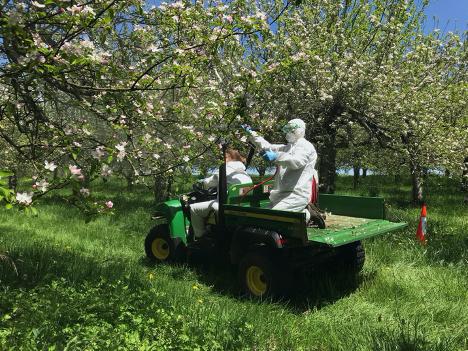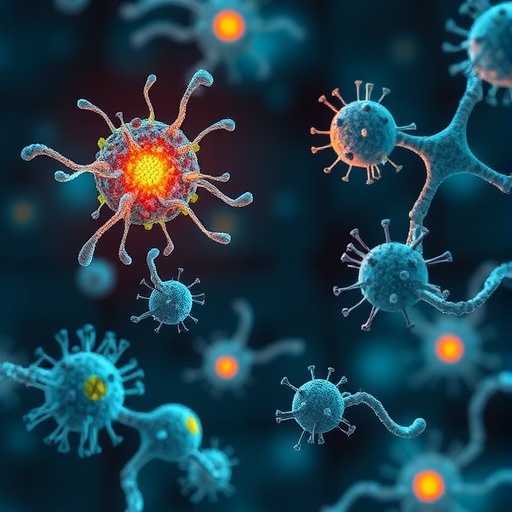
Credit: Zhouqi Cui, Regan B. Huntley, Neil P. Schultes, Blaire Steven, and Quan Zeng
While many celebrate apple blossoms as classic signs of spring, they are also welcoming entry gates for pathogens. Full of nutrients to lure pollinators and promote pollen germination, flowers also attract bacteria like Erwinia amylavora, a pathogen that causes a damaging disease called fire blight. However, recent work by scientists at the Connecticut Agricultural Experiment Station suggests that these flowery infection sites might also be perfect targets for applying microbial fire blight biocontrol measures.
In a paper recently published in Phytobiomes Journal, researchers Zhouqi Cui, Regan Huntley, Neil Schultes, Blaire Steven, and Quan Zeng found that treating apple flowers with a probiotic spray reduced incidence of fire blight. They sprayed blooming trees with different strains of bacteria isolated from apple flowers and then exposed the same blooms to the fire blight pathogen. After this inoculation, they sampled the floral microbiomes and observed the development of fire blight symptoms.
They found flowers treated with Pantoea spp. bacteria developed distinct microbiomes and exhibited fire blight symptoms 35 to 45 percent less frequently than flowers treated with just water. These results suggest that Pantoea spp. structure floral microbiomes in a way that reduces infection and could be an effective probiotic biocontrol for fire blight. Flowers may be a particularly promising system in which growers can actively influence microbiomes–compared to roots and leaves, flowers are short-lived, which could make reshaping their microbiomes both more technically feasible and biologically impactful.
This research underscores the importance of studying apple flower ecology in the field. While many researchers simply screen bacterial isolates in the laboratory, Cui and colleagues studied how these natural strains altered flower microbiomes and disease rates in the field. This step was crucial as the bacterial strain that suppressed the fire blight pathogen most strongly in the lab failed to substantially reduce infections in the field while Pantoea spp., the strain with the promising fire blight reduction in the field, did not directly suppress pathogen growth in the lab.
The authors suggest that the ineffectiveness of biocontrol agents in field settings may be due to the products’ incompatibility with natural plant microbiomes. “Typical studies…often fail to even test if the applied strain effectively colonizes the flower” the authors note. As evidenced in their study, laboratory results can sometimes show false promise, but in some incidences–as with the case of Pantoea, may allow promising biocontrol agents to be overlooked.
###
To learn more about this research, read the original article published in Phytobiomes Journal: “Inoculation of Stigma-Colonizing Microbes to Apple Stigmas Alters Microbiome Structure and Reduces the Occurrence of Fire Blight Disease.”
The lead researcher on this project, Dr. Zhouqi Cui (@CuiZhouqi), is interested in the dynamic interactions between the plant microbiome and plant pathogens on agricultural crops. She is currently a postdoctoral scientist at the Connecticut Agricultural Experiment Station (@CT_CAES) and is looking for a permanent research position in the near future. Dr. Blaire Steven, a co-PI on this project is a microbial ecologist with broad interests in how microbial communities are acquired and assembled. His work includes the microbial ecology of permafrost, desert and agricultural soils, the mosquito microbiome, as well as the work on the apple flower phytobiome. Dr. Quan Zeng (@oldkayak), the corresponding author, is an Associate Scientist in the Department of Plant Pathology and Ecology, Connecticut Agricultural Experiment Station and graduate faculty at the Department of Plant Science and Landscape Architecture, University of Connecticut. His research interests include plant-associated microbiomes and their impact on plant diseases, and bacterial plant pathogens and diseases.
Author Bio: Dr. Mia Howard (@mia_how) is an assistant feature editor for Phytobiomes Journal and a postdoctoral researcher in Dr. Jen Lau’s lab at Indiana University. She is fascinated by how plants–often with help from microbes–protect themselves from herbivores with toxic chemicals.
Media Contact
Mia Howard
[email protected]
Related Journal Article
http://dx.




